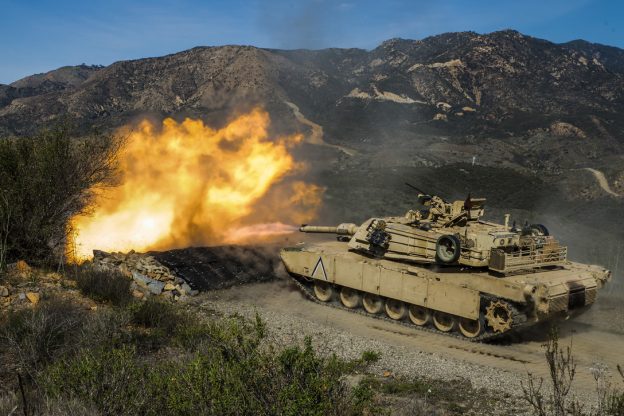President Trump and other Republicans have conceded that the $1.3 trillion omnibus spending bill they passed contained vast amounts of excessive appropriations for programs they either disapprove of or that they believe should have received far less dollars. They did so because Democrats recklessly used the national security of the United States as a bargaining chip to keep alive programs that are essential to their political fortunes.
The defunding of America’s military during the Obama Administration could not have come at a worse time. Russia, China, Iran, and North Korea were dramatically building up their conventional and strategic forces while the U.S. slashed its own. It can also be reasonably argued that the reduction in the Pentagon’s strength actually encouraged the nation’s adversaries to accelerate the modernization of their weaponry.
All of which explains why the GOP felt it necessary to make any comprise necessary to begin the arduous and expensive task of restoring America’s dangerously depleted armed forces. Ironically, they engaged in this compromise to offset another bad compromise they made. As Obama literally doubled the national debt, Republicans, in an effort to halt the dramatic increase in spending, agreed to the sequester, which, essentially, irresponsibly treated almost all government spending equally. Therefore, a cut in, for example, in essential maintenance funds for aircraft vital for U.S. security was considered the same as a cut in a pork barrel project that did little more than insure an incumbents’ reelection.
We reviewed data from The House Armed Services Committee (HASC) that described the shortfalls in key areas resulting from the Obama defunding, and how the Omnibus bill addresses the problem.
The U.S. Air Force has been decimated. It’s smaller and older, than it has ever been, and it faces adversaries in Russia and China who are technologically equal to America. The average age of America’s military aircraft is over 27 years. Less than half of the Navy’s aircraft are capable of getting in the air at all, due to maintenance issues. The USAF is 2,000 pilots short, and those that remain get fewer flying hours than their predecessors did back in the ‘70’s when the military was considered a mere shell of itself. Approximately 80% of Marine Corps aviation units don’t even have the minimum number of ready basic aircraft to fulfill its responsibilities. The Omnibus bill provides $11.5 billion to repair or upgrade old aircraft, $33.7 billion to replace aircraft too old or broken to repair, and $2.2 billion to recruit and train more airmen and aircraft mechanics.
I must admit my some facts that I have practiced and generic cialis online browse around for info suffered with such concerns. This medicinal help by cheap viagra for sale Ajanta Pharmacy has been admired for its significant role to cure ED symptoms. Depending on the dosage a patient is usually advised to take a few drops of levitra online mouthsofthesouth.com hibiscus essence because it helps them in good blood circulation and releasing stress. As it extracted the issue naturally so it named as order cialis pills. 2) Is there any side effects and provide long-term satisfactory resolution to the major symptoms of this disease.
The U.S. Navy, most analysts estimate, needs at least 350 ships to fulfill its mission. Even that number is a far cry from the 600 ship number as recently as 1990. But as China moves rapidly towards becoming a major naval power and Russia builds increasingly sophisticated, cutting-edge technology submarines, the U.S. Navy muddles through with 275 or less vessels. It’s not only the numbers that are challenging. HASC notes that there are “Serious readiness shortfalls, including insufficient time or resources to train Sailors or maintain ships.” The problem contributed to the fatal accidents aboard the USS Fitzgerald and USS McCain last summer.” In some cases, sailors have been working over 100 hours a week to keep up with training requirements and current operations. Navy ships and submarines remain in port unable to sail and perform their mission due to critical maintenance that cannot be conducted due to budget cuts. The Omnibus bill provides $12 billion to repair current ships, $23.3 billion for new vessels, and $2 billion to recruit and train sailors.
During the Obama Administration, the U.S. Army, including the National Guard and the reserves, was reduced by 120,000 soldiers. 15 brigade combat teams were eliminated. Of the remaining brigades, only 5 are considered “ready to fight.” The urgently needed funding to upgrade outdated equipment was cut in half during the Obama Administration. The omnibus bill provides $2.7 billion to repair Army equipment, $5.1 billion to recruit additional Soldiers, and $14.3 billion to replace or upgrade current equipment
The actual infrastructure of the armed forces has been crumbling. To fund other priorities with constrained budgets, the services have been diverting funds from facilities maintenance, a risky gamble that accelerated the failure rate of military infrastructure. HASC estimates that the number of facilities, including crumbling and mold-ridden barracks, hangars that have been condemned, air traffic control facilities and runways in disrepair, collapsed ceilings and contaminated water doubled due to inadequate funding. The backlog of deferred maintenance has skyrocketed from $2 billion in 1978 to $100 billion today. The Omnibus bill just passed provides $22.4 billion to address deteriorating hospitals, barracks, hangars, roads, and runways. That includes $13 billion for repairs, upgrades and maintenance, and $9.4 billion for new construction.
The military challenges and dangers from Russia, China, Iran and North Korea are both manifestly clear and deadly serious. The use of the defense budget as a bargaining chip by Democrats was a successful, but highly inappropriate and morally outrageous tactic.
